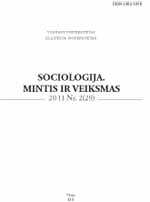Stipriųjų ir silpnųjų ryšių svarba protesto mobilizacijai: Sąjūdžio genezė ir raida 1987–1988 metais
Effects of Strong and Weak Ties in Protest Mobilisation: the Genesis and Development of Sąjūdis, 1987–1988
Author(s): Ainė RamonaitėSubject(s): Social Sciences
Published by: Vilniaus Universiteto Leidykla
Keywords: social movement; weak ties; strong ties; social network analysis; collective action; contentious politics
Summary/Abstract: In analysing the dynamics and mechanisms of mass protest from 1987 to 1988 in Lithuania, this article explores what kind of social ties – strong or weak – are conducive to the mobilisation of collective action in a (post-)totalitarian society. The empirical analysis is based on data collected as part of the 2009-2011 research project ‘The Phenomenon of Sąjūdis: Network Analysis of a Civic Movement’. First, the article defines the distinction between strong and weak ties, and highlights the importance of social networks for the mobilisation of collective action. Second, it analyses the micro-structure of Lithuanian society in the Soviet period. Based on the type of network ties, three distinct social arenas are distinguished: underground society, alternative legal society and official society. Finally, the article analyses which of these arenas could be seen as the seedbed of the Sąjūdis movement. Also demonstrated is the distinct role of different kinds of social ties at different stages in the development of the movement.
Journal: Sociologija. Mintis ir Veiksmas
- Issue Year: 2011
- Issue No: 02
- Page Range: 199-217
- Page Count: 19
- Language: Lithuanian

